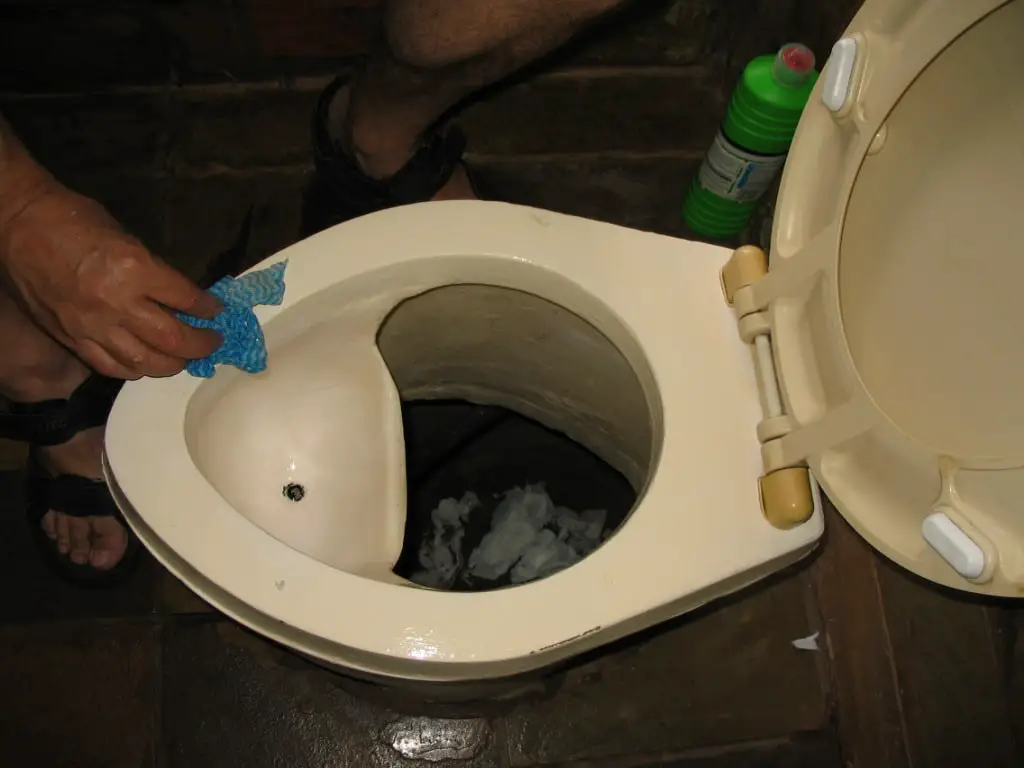Toilet Seat Residue, Sitting has been the preferred toilet method since the invention of flush toilets, making the toilet seat an essential component. However, sitting means your skin will always be in contact with toilet seats. It’s therefore critical to keep the seats clean at all times to guarantee you stay clean and sanitary.
You may, however, leave leg residue on the toilet seat, which can be terrifying and inconvenient for other bathroom users. This problem originates from various reasons, including skin conditions and diseases.
To successfully remove leg residue from your toilet seat, you must first establish the source of the problem, as this will help you choose the best solution. This article examines the causes and suggests solutions.
Table of Contents
Legs Leaving Residue on Toilet Seat: The Reasons Why

There could be a variety of factors that contribute to the legs leaving residue on the toilet seat. So, let’s look into the possible causes of these problems.
Skin Diseases
Not everyone has flawless skin. People can get various skin illnesses from various causes, especially in areas like the thighs, which are more prone to bacteria.
Some people may begin to use commercial products or medicines due to this.
When someone with skin disease comes into contact with the toilet seat, spots remain on the toilet seat due to the skin disease.
Thighs That are Oily or Have Dirt in Them
Some people have oily skin naturally. It’s a pretty prevalent condition that can affect men and women alike. And this condition impacts other regions of the body, such as the thighs, which come into touch with the toilet seat.
The sebaceous glands are to blame for this condition. They lead to the production of sebum oil. As a result, such a skin type attracts much dirt and other contamination to the skin.
And all this dirt gets onto the toilet seat from the user’s thigh, putting a spot on it. Pregnancy, hot weather, birth control pills, hormonal issues, cosmetics, poor dietary habits, and other factors can all contribute to oily skin.
Skin Peeling Off
The human skin can peel off for various reasons, and the skin peels can remain on the toilet seat. These problems can arise from any part of your body.
This problem occurs in the body in some cases, such as genetic disorders, fungal infections, immune system disorders, allergies, cancer, etc.
Some diseases, such as having dehydrated skin and some unusual diseases, could also cause this problem.
Harsh Cleaning Products
Every day, we use a lot of chemical products. Because the elements are not natural, not all are suitable for our skin.
Furthermore, many skin-cleaning products contain harmful chlorine bleach, which can cause severe irritation and harm to the skin.
All these cause the skin to shed and end up on the toilet seat.
Wearing Clothing That Is Too Tight Or Uncomfortable
Skin irritation can be caused by tight or uncomfortable clothing, and the skin may eventually be shed on the toilet.
How to Solve the Problem of Legs Leaving Residue on Toilet Seat
Any residue left in the bathroom can destroy your bathroom experience.
As a result, it’s essential to address the problem of legs leaving residue on the toilet seat as soon as possible.
Clean the Toilet After Every Use
It is everyone’s responsibility to clean the toilet seat after each usage. A disinfectant can be used to clean the toilet seat.
After that, toilet tissue paper can be used to wipe the toilet seat to keep it dry.
Use A Squatty Toilet Stool
Most experts agree that the natural position is the best way to ensure that the toilet seat does not touch the users.
In addition, the toilet’s position is ideal for ensuring that it is used healthily.
Use Toilet Seat Covers
Using a toilet cover will prevent the leg residue from remaining on your toilet seat. The toilet seat covers may be found at practically every retail store and can be utilized in restrooms of all kinds, including offices, schools, and even homes.
Maintaining Good Personal Hygiene
Personal hygiene is something that everyone should be aware of. If you’re having trouble with your skin, get it treated as soon as possible.
Also, understanding how to use the restroom is especially important for persons with skin problems.
Removing the Dead Skin

Exfoliation should be a component of your skincare routine because it aids in the removal of dead skin cells that could otherwise wind up on your toilet seat. You can use an exfoliating brush, exfoliating scrub, exfoliating sponge, or an exfoliating glove to do this manually.
Alternatively, you can try the chemical way with Beta-hydroxy acids (BHAs) and Alpha-hydroxy acids (AHAs). However, exfoliating legs and arms is best done using a glove, sponge, or brush.
You can also attempt airbrushing while showering to get rid of dead skin.
Frequently Asked Questions
What Can You Catch From Toilet Seat?
Sitting on a toilet seat can spread pathogens such as E. coli, Streptococcus, Shigella bacteria, and Staphylococcus. Furthermore, toilet seat dermatitis can be caused by harmful chemical cleaners, and wooden toilet seats can induce allergies.
Avoiding harsh cleaners, utilizing plastic toilet seats, and utilizing toilet seat covers, especially in public restrooms, will help reduce contact dermatitis.
What is That Black Substance on Your Toilet Seat?
If you notice a black substance on your toilet seat, you can be sure that bacteria, mildew, molds, and minerals are present in your toilet. You can only avoid them by cleaning the toilet regularly.
Why Does Your Toilet Develop Mold So Quickly?
When your toilet has stagnant water, it can act as a catalyst for mold to grow quickly.
What Foods are Known to Cause Dermatitis?
A few substances in our diet may cause dermatitis to flare up. These foods include milk, wheat, eggs, soy, fish, and peanuts.
Final Take
When we visit a toilet to seek some much-needed relief, having legs leave residue on the toilet seat is a nightmare for all of us.
As you can see, there are a variety of causes for this problem, and simply taking simple precautions and raising user awareness can greatly reduce the severity of the problem. So, the next time you encounter this issue, you’ll know what to do.


